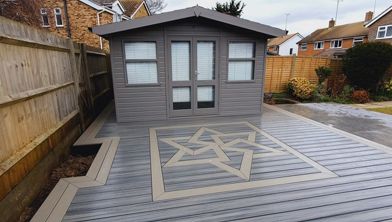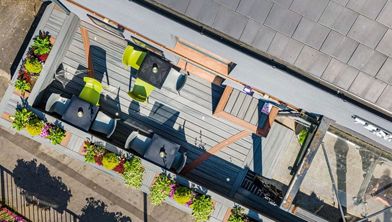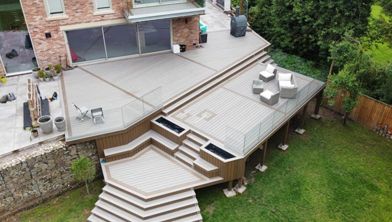Ten Tips For Building A DIY Deck
Homeowners are constantly faced with whether to tackle a home improvement project by themselves or hire a professional. Save money or save the headache. If building a deck is on your DIY to-do list, there are a few things to consider before you invite friends and family over for a summer BBQ.
#1: Skilled Or Not Quite?
The first question to ask yourself is do you have the appropriate carpentry skills to complete the project?
“Be realistic as to whether it’s within your skill set,” says Trex Senior Product Manager Mel Karlson, who has built many decks, including his own, and has advised on many others. “Lots of contractors tell us customers start out as DIYers and then realise they’ve gotten in over their heads.”
The myriad do-it-yourself shows commonly found on DIY Network and HGTV inspire many homeowners to take on their own home improvement projects. But ask yourself, can you precisely lay out footers? Can you comfortably square up a deck? Can you work a circular saw and other power tools? Do you understand proper gapping and fastener techniques?
If you have the necessary skills and feel confident enough to tackle the project, consider watching some how-to-videos and consulting DIY guidebooks for additional help.
#2: Legal Requirements
In most cases, building permits are required before you start construction. You need to ensure your deck plan meets local building codes and safety standards. In addition, some states require stamped construction drawings from engineers when applying for a permit. Know your setbacks and easements which are particularly important in neighbourhoods with covenants and restrictions. Fines can be steep and delays costly. Building without a permit can also pose a problem when you try to sell your house and a prospective buyer or home inspector finds there is no permit on file with the local building office.
“Buyers want to know the deck was soundly built,” Karlson says. “You may find yourself in a situation where in hindsight you will wish you had just gotten a permit.”
If you are part of a Homeowner’s Association, you’ll need to be aware of those requirements as well. Associations can limit the type of materials you are able to use and require specific styles of railing and balusters. Do your homework. Ask for guidance. Check with neighbours who have already gone through the process.
Avoid Installation Hurdles
If you’re using wood-composite materials such as Trex decking and railing, always follow the manufacturer’s installation guidelines. These guides, as well as online installation videos, will help you construct a safe structure, and ensure that you maintain your warranty. While building techniques for wood-composite decking are similar to wood construction, there are unique details you should be aware of such as storage, gapping and fastener recommendations.
#3: Design For Your Lifestyle
No matter the size and shape of your deck, you will benefit from careful planning. After determining setbacks, take into consideration the size of your lot, sun, shade and your view.
Your view is paramount when designing the details of your space. “Homeowners often overlook the placement of posts and beams, which can severely impede a view if positioned without thought,” Karlson says.
Consider how you will live in the space. Do you like to entertain large crowds? Will you need space for a grill, dining table or perhaps a fully appointed outdoor kitchen with appliances, storage components and all the related conveniences? What about a separate conversation area for friends to gather and relax? Are you more solitary in your outdoor pursuits? Perhaps a simple reading nook is all you require, or a creative and functional privacy screen might be in order. Don’t limit your plans to immediate needs. A properly built deck is something you can enjoy for 25 or more years. Plan for the future. Is a hot tub on your bucket list? It’s wise to frame for that now even if it’s not in your current budget.
“Plan for these things so they’re not an afterthought. You don’t want to build your deck only to find out you have a post smack in the middle of your doorway (view).”
#4: Railings Shouldn’t Be An Afterthought
Railings are often overlooked during the design phase of a deck build. But if your deck is more than a 2 feet off the ground, railings will be required for safety reasons. Since railing tends to be one of the most expensive parts, and is the most vital aesthetic detail of an outdoor space, it’s important to spend time mulling your options. Karlson suggests you choose your railing first. “That’s what you see when you look out and back at your house,” he says. “In addition to being functional, it’s an architectural feature. Just like shutters, you want your railings to be complimentary to your home.” And are there ever options. An explosion of materials, finishes, colours and rail styles present homeowners with a great deal of choices. Finding the right match is the fun part of planning, but it can be overwhelming. To simplify the process, Trex has developed a series of curated looks. Trex’s Decking & Railing Duos pairs our popular Transcend tropical decking colours with various railing combinations to help you make a beautiful aesthetic selection with ease.
#5: Avoid Mistakes
With decades of experience in the building industry, Karlson has witnessed deck building basics that simply get overlooked by the DIYers. Here are a few additional tips to alleviate potential headaches.
#6: Gapping Disasters
Proper gapping is necessary for water drainage and expansion and contraction, and also allows for the shrinkage associated with wood joist systems. Consider using Trex Hideaway Hidden Fasteners which create proper gapping when used with our grooved-edge boards.
#7: Crown Your Joists
Wood joists are rarely straight. It’s wood, after all. “Crown your joists,” Karlson reminds homeowners. “It’s a common mistake.” And if you aren’t familiar with crowned joists, you just may want to reconsider a DIY experience.
#8: Trim Ends
Wood-composite boards straight from the manufacturing plant do not always have perfectly clean cuts. Karlson suggests you trim each end of the deck board before installing for a cleaner, squarer finished appearance.
#9: Start Outside
DIYers often begin with a full deck board butted up against the house, but Karlson advises you to start attaching boards from the outside of the deck, working your way toward the house. When you reach the house, you can then rip the final deck board to the required size. Since it’s up against the house, the smaller board is less noticeable.
#10: Pre-Drill
Pre-drill surface screw holes to avoid splitting the end of the boards.
Building a beautiful deck can be a rewarding experience. You’ll have something to show for all your sweat equity. But understand what you’re getting into before digging that first post hole. Make sure you’ve prepared properly and are capable of dealing with problems that will surely arise. Or your wisest move might be picking up a phone and calling a professional.
This content was partially or fully generated by AI and has been reviewed by our team to ensure accuracy and relevance.




































